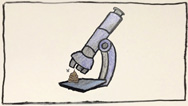Can Microbes Solve Crimes?
- By Anna Rothschild
- Posted 10.29.15
- NOVA
Meet your necrobiome—the microbes that thrive on your body after you die. Now, scientists are looking to these tiny organisms to solve mysterious crimes. Find out more in this episode of Gross Science.
Transcript
Can Microbes Solve Crimes?
Posted: October 29, 2015
As you probably know from crime shows or movies, when we die, our bodies can become feasts for insects, vultures, and other animals. But there’s another group of living things that plays a big part in how we decompose, and could help forensic scientists make sense of mysterious crime scenes. This is our necrobiome, the hordes of microorganisms that that take over once we take our last breaths.
I’m Anna Rothschild, and this is Gross Science.
Everyday, you carry with you trillions of bacteria and other microbes. Scientists call this your microbiome, and, while you’re alive, these guys live in harmony with your own cells.
But, once you (or really any animal) dies, all that goes out the window. The microorganisms—especially the ones in the gut—start breaking down the body’s cells and multiplying in a process called “putrefaction.” To illustrate this, meet my very hungry friends, Joe and Vanessa. Essentially, they spread through the body and eat it from the inside. They also produce foul smelling chemicals and gasses that inflate the body like a morbid balloon, leading to what’s called the “bloat” stage of decomposition.
At a certain point, so much gas builds up that the carcass may “rupture,” exposing its insides to the elements. And this is when things get interesting. Up until now, most of the microbes present were anaerobic, meaning that they like places without oxygen. But after rupture, the microbes in the body cavity become primarily aerobic, or oxygen-loving, as bacteria and fungi from the environment—along with those carried by insects and other animals— begin to colonize it. At the same time, fluid starts to “purge” from the ruptured corpse, which can change the pH and nutrient content of the surroundings—and thus change which microbes are hanging out near the body, as well.
For years investigators have used clues from the environment to estimate how long someone’s been dead. For example, larvae from different insect species tend to appear at different times. But, not every body becomes a bug buffet, depending on lots of things like the location or the weather. Bacteria though are everywhere, including on and inside of you. So, could the necrobiome be even more useful in estimating the time of death?
Well, researchers recently tested this idea in mice. Different combinations of microbes were always present on the skin and around the body at different times after death. And the scientists found that this microbial fingerprint could be used to estimate time of death within about plus or minus a three days.
Obviously, more tests will need to be done to see if this “microbial clock” works as well outside of a controlled experiment, or in humans with our varied microbiomes. But it’s a promising first step to harnessing the power of the necrobiome, in all its putrid, smelly glory.
Ew, Vanessa!
Credits
PRODUCTION CREDITS
- Host, Writer, Editor, Animator
- Anna Rothschild
- DP, Sound, Research, Fact-Checking
- Ceri Riley
- Sugar Plums a
- Music Provided by APM
IMAGES AND FOOTAGE
- Flying Vultures
- Pond5/mateosclips
- Maggots Maggots in Rotten Meat
- Pond5/More_beans
- Sarcophaga nodosa
- Wikimedia Commons/Muhammad Mahdi Karim
- Police Line Crime Scene 2498847226
- Wikimedia Commons/Tony Webster
- Proteus, SEM
- David Gregory&Debbie Marshall, Wellcome Images
- Single-leaf pine (Pinus monophylla); Pine City Trail
- Wikimedia Commons/Robb Hannawacker, while working for Joshua Tree National Park
- Occluded mesocyclone tornado5 - NOAA
- OAR/ERL/National Severe Storms Laboratory (NSSL)
SFX
- Cockroaches
-
Freesound/StateAardvark
(used with permission from author) - Squeak Pack/squeak_10
- Freesound/Corsica_S
- Swishes
- Freesound/pogotron
- Gagging-1
- Freesound/turroe22
- Short Fart 1
- Freesound/dsisstudios
- Cough Couch Sniff Sniff
- Freesound/harrypeeks
- Laughing gas/nitrousoxide/nos balloon inflation audio sample #08
- Freesound/blinkyspoogle
POSTER IMAGE
- Dead Mouse
- ©WGBH Educational Foundation 2015
Sources
Want more info?
Study on estimating time of death with microbes:
http://elifesciences.org/content/2/e01104
The Ecology of Carrion Decomposition:
http://bit.ly/1jLKsP4
BBC Future on using bacteria to solve crimes:
http://bbc.in/1jLKMxf
Do Animals Mourn?:
https://youtu.be/rHJDmMSKlHM
The Surprising Ways Death Shapes Our Lives:
https://youtu.be/Joalg73L_gw
Related Links
-

Gross Science
Bizarre stories from the slimy, smelly, creepy world of science.
-

How Dirty Are Public Restrooms?
What is lurking in the bathroom?
-

The Power of Poop
Poop is a great source of fertilizer, heat, and electricity.
-

Why Get Your Tetanus Shot?
Avoiding your tetanus shot? Here’s why that might be a bad idea.

